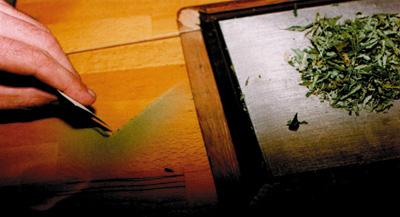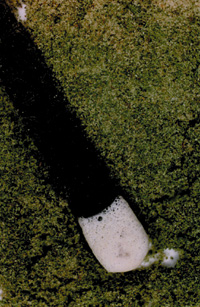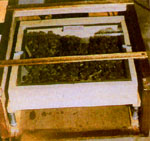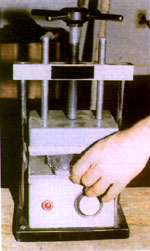 Gardeners who romance the bud know that the leaves, the natural by-product of their work, present an interesting paradox. It is bud with perhaps 5% THC that is typically the focus of their obsession. Commercially this jewel is valued by consumers and it sells for several thousand dollars a pound. The fan leaves, which contain 1% or more THC but provide a much harsher smoke, are often thrown away by these connoisseurs, and has a very small commercial value. Trim, which contains 2% or more THC, commands only a little more respect, and is also moderately priced.Mature marijuana plants typically yield half as much or more leaf as bud by weight. The result is that 10-15% of the plant's total THC production is often thrown away. Most gardeners have been content to sacrifice these glands to poor relatives, high bakers or the trash. Recently, Maila's "Pollinator" has regenerated interest in a solution to the leaf conundrum. A few years ago, the late John Gallardin developed the Sifter and Master Sifter. Both of these devices are based on the silkscreen used worldwide. Maila's device looks and operates much like a front loading washing machine. John's is a frame which holds a screen and glass plate. His "master sifter" used a vibrator similar to a paint mixer to shake the grass.
Gardeners who romance the bud know that the leaves, the natural by-product of their work, present an interesting paradox. It is bud with perhaps 5% THC that is typically the focus of their obsession. Commercially this jewel is valued by consumers and it sells for several thousand dollars a pound. The fan leaves, which contain 1% or more THC but provide a much harsher smoke, are often thrown away by these connoisseurs, and has a very small commercial value. Trim, which contains 2% or more THC, commands only a little more respect, and is also moderately priced.Mature marijuana plants typically yield half as much or more leaf as bud by weight. The result is that 10-15% of the plant's total THC production is often thrown away. Most gardeners have been content to sacrifice these glands to poor relatives, high bakers or the trash. Recently, Maila's "Pollinator" has regenerated interest in a solution to the leaf conundrum. A few years ago, the late John Gallardin developed the Sifter and Master Sifter. Both of these devices are based on the silkscreen used worldwide. Maila's device looks and operates much like a front loading washing machine. John's is a frame which holds a screen and glass plate. His "master sifter" used a vibrator similar to a paint mixer to shake the grass.
Once the public understands the basic concept behind silk screening, many new devices to separate glands from vegetation will be developed. They will range from simple to sophisticated, but all of them will effectively separate the stash from the trash.

Glands screened using 120 strand per inch mesh for 2 minutes
thc is everywhere
Tetrahydrocannibinol (THC) is the psychoactive component of marijuana. It is produced on the stems, leaves, and vegetation surrounding the flowers, and it is stored in glands which emerge from the surface. On the stems and the early fan leaves these glands are small and hug the surface, while the glands on more mature plants are stalked and look like a mushroom with a bulbous cap.
The flowering areas of the female plants and the small leaves surrounding them contain the most THC. However, all the leaves from the female plant contain retrievable THC. Male plants produce THC as well, and they are most potent at the budding but pre-flowering stage. In both cases, the small leaves near the flowers are the most potent, followed by the younger and then older fan leaves.

Glands screened at 150 lines mesh for 2 minutes. Notice how much more grey it is than the 120 line mesh. The tongue of a key enters the photo from the bottom.
another fine mesh
In countries close to the 30th parallel, such as Nepal, Afghanistan and Lebanon, THC glands have traditionally been separated from the plant and concentrated into hashish. The glands are separated mechanically from the grass using a silk scarf stretched tightly over a bowl. Some hashmakers have switched to metal screens instead of the scarves, since they are very durable and easy to frame.
John used a wire mesh with a 100 strands per inch. The material which fell through the mesh had a greenish colour, which indicates that vegetative material containing chlorophyll has fallen through. A 120 mesh screen produces a tanner color, indicating fewer impurities. A 150 mesh screen produces an even cleaner mix which has a gray-tan color.
The Moroccan rating system for hash, starting with double zero, then zero, and so on, referred to the stage of sifting from which the glands were collected. Zero zero came from the first pass, zero from the second, and lesser grades from subsequent passes over the screen. With each screening a higher proportion of impurities mixes with the glands.

The late John Gallardin's "Master Sifter" used a motor and springs to vibrate grass automatically. The glands collected on the pull out glass plate.

A hydraulic press does a good job of pressing the glands. For a more professional looking product, the glands can be pressed inside a mold, which will produce a better shape and een imprint a symbol.
not all glands are created equal
The quality of the marijuana affects the quality of the hash, too. Moroccan hash is made from plants of marginal potency. A Moroccan gland does not contain as much THC as a Nepalese gland.
Within a specific variety individual plants vary in the number of glands they have per square centimeter. The result is that some plants are more potent than others.
In Holland several growers told me that they observed that gland size differed by variety. One observed that "hash plant" hybrids were covered with large sized glands as compared with some sativas, which he said, had smaller bulb heads.
cooler heads prevail
In Morocco, the grass is harvested in mid to late August, dried and then placed in unheated sheds. It is not until winter, when the temperature drops below freezing and the air loses its moisture, that hash making begins.
Meila recognized the value of dry weed in cool dry air. One of the pollinator models is designed to be placed in a refrigerator. When either the leaf or air is warm or moist the glands become pliable rather than brittle. When everything is dry and crisp the glands glide through the screen much easier.
a pressing issue
The glands are delicious smoked fresh and loose. However, some traditionalists insist that they be pressed into hash. John's attempts at it using a press were only semi-successful. The glands pressed together, sort of like sandstone; the individual grains had not congealed. The problem was the lack of heat. In order to metamorphose into hash. The glands must become viscous enough so that their membranes break and the liquid inside can flow.
Joop, who makes a press sold at Positronics in Amsterdam, solved the heat problem by placing the weed in a cellophane bag, putting the bag inside a waterproof plastic bag and heating the glands in boiling water, then pressing. This yielded hashish.